Engagement Rings 101: A Practical Guide To Buying
Snag that sparkly symbol of love with confidence!

Ada Diamonds | Laboratory-grown Radiant Petite Four Prong Solitaire
Regardless of what you ultimately spend on an engagement ring, one thing's for certain – this is one of the biggest purchases of your life! Not necessarily due to the dollar amount, but because of everything this ring represents. It's a symbol of unconditional love, but you also want your significant other to love it. #nopressure
So how do you choose the right ring? Read the tips, terminology, and FAQs below for the ultimate guide to buying an engagement ring!
The Four Cs
If you're considering buying a diamond, let's start with the basics. The diamond industry uses four factors – cut, color, clarity, and carat – to "grade" diamonds based on quality, rarity, and value. Each of the 4 C's factor into a diamond's beauty and brilliance, and gives you a framework to help evaluate its quality and cost.
CUT
When you hear the words "diamond cut", you may automatically think of princess cut, cushion cut, or emerald cut. But diamond cut actually refers to how brilliantly a diamond's facets or angles interact (sparkle) with light. A diamond's cut is evaluated by the precise symmetry, proportion, dimension, and polish of the stone.
Pro Tip: Only round diamonds are graded for cut, and it's all math. Cut is a measure of light refraction, which the human eye really can't discern at all. You'll want to buy a very good or higher cut grade for that rainbow sparkle you imagine when you think of a diamond.
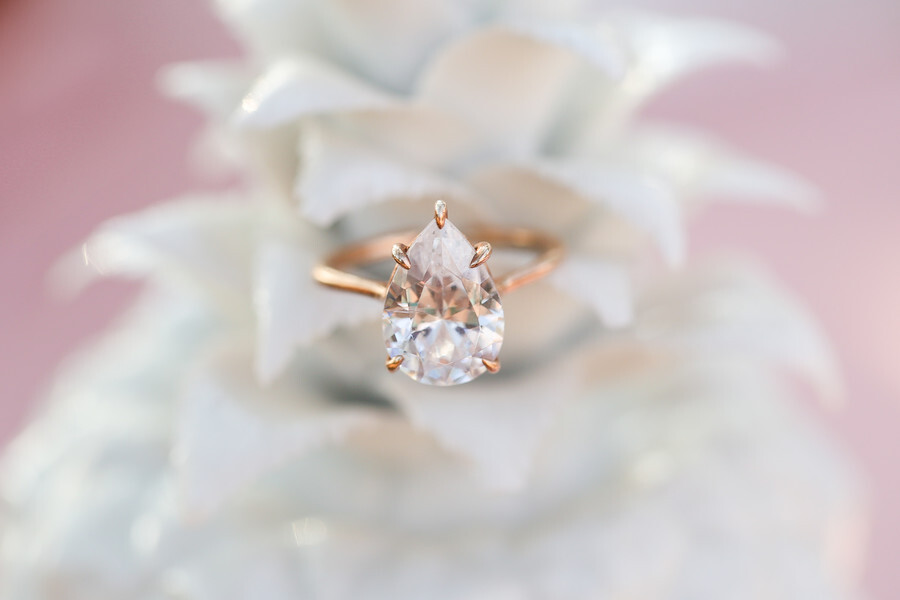
Susie Saltzman Fine Jewelry Banks Custom Engagement Ring | Fresh Look Photography
COLOR
Diamond color... Or, lack thereof. That's right – with diamonds, the less color, the better. Per the GIA, "A chemically pure and structurally perfect diamond has no hue, like a drop of pure water, and consequently, a higher value." Ideally, you want your diamonds to be colorless.
Assessing color in diamonds is like buying white paint. Look at a single paint sample and it's white, but compare it to other "white" paint samples and you begin to see varying shades of white.
The Gemological Institute of America (GIA) has a D-to-Z diamond color-grading system which measures the degree of colorlessness. And while they can be hard to discern with the naked eye, color grade can really impact your bottom line.
Pro Tip: Here's a simple guide to diamond color: H-to-Z is yellowish (an especially unfortunate option if the diamond will be set in yellow gold), G is the best value overall (really, really white without getting into the colorless range), and D-to-F are considered colorless (and very difficult to discern from one another).
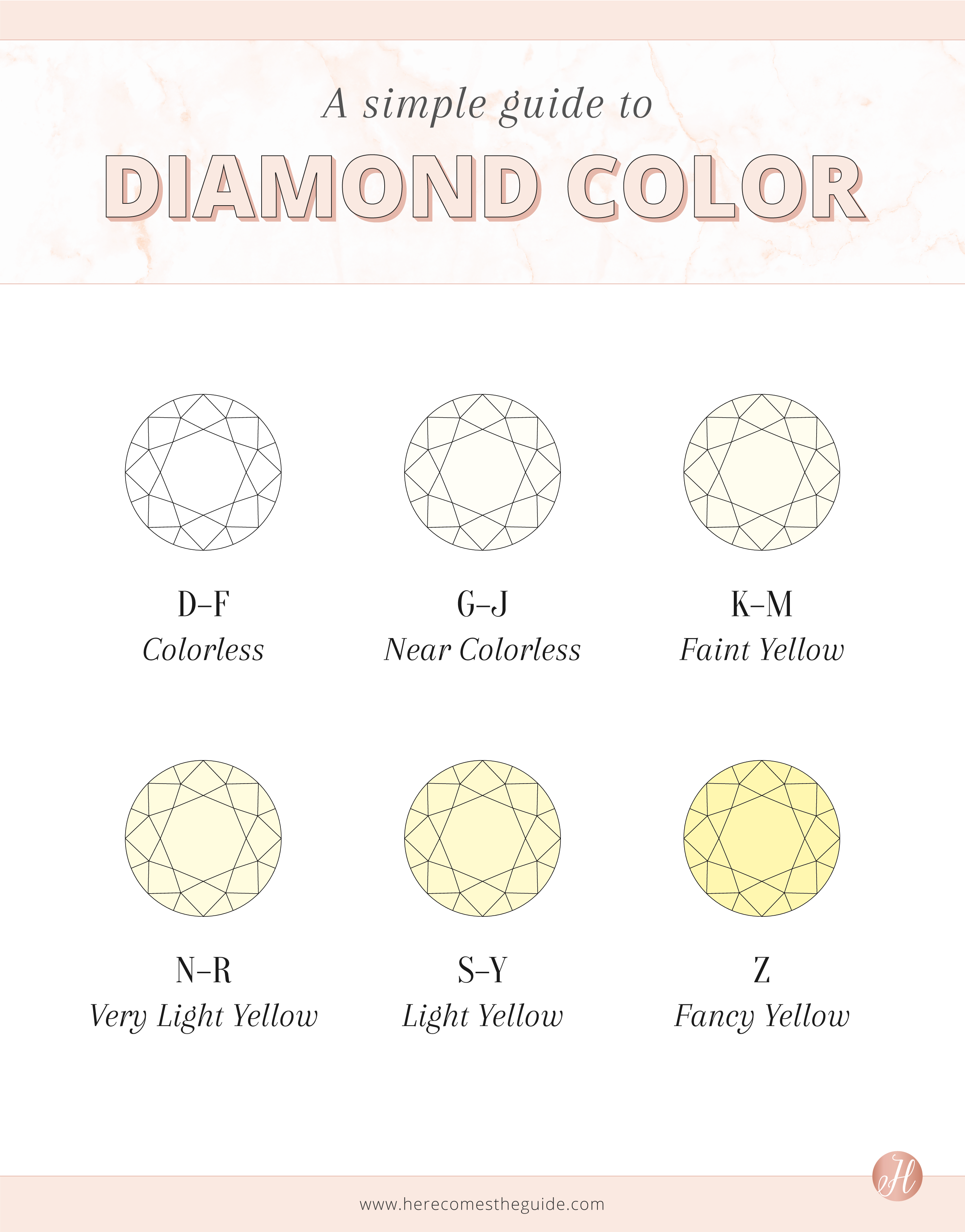
CLARITY
We've all heard that quote by Henry Kissinger, "A diamond is a chunk of coal that did well under pressure." And it's true: natural diamonds are formed from carbon under intense heat and pressure deep within the Earth's crust. So naturally they're gonna have a few imperfections (which the diamond industry refers to as "inclusions").
According to GIA, "Diamond clarity refers to the absence of inclusions and blemishes." The GIA Diamond Clarity Scale has 6 categories and 11 grades, ranging from Flawless to Included.
Pro Tip: Clarity is about rarity—and if choosing a round diamond, it's invisible unless you get down into the Slightly Included (SI1) range. That's when the tiny inclusions (which all diamonds have when judged under 20x magnification) start becoming visible to the naked eye. A Very Slightly Included (VS2) and an Internally Flawless (IF) diamond look identical in person; they are just different under magnification. So as long as your stone looks eye-clean and sparkly, you're good to go!
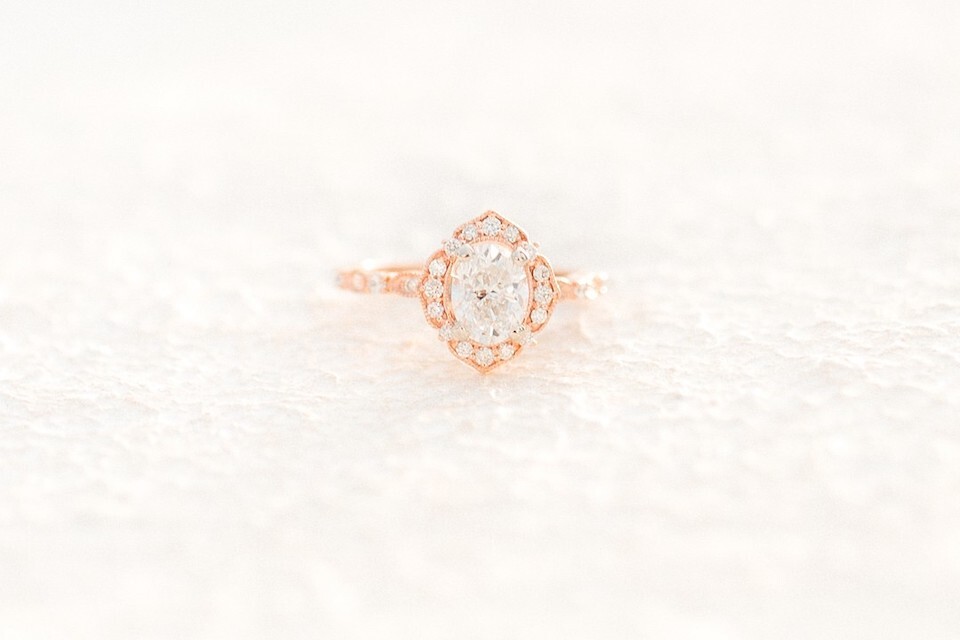
Shane Co. Vintage Oval Halo Diamond Ring | Kaitlyn Blake Photography
CARAT
Does size matter? When it comes to diamonds, yes! Carat measures how much a diamond weighs, with a metric carat being defined as 200 milligrams. According to the Gemological Institute of America, "All else being equal, diamond price increases with diamond carat weight because larger diamonds are rarer and more desirable. However, two diamonds of equal carat weight can have very different values (and prices) depending on three other factors of the diamond 4Cs: Color, Clarity, and Cut."
Pro Tip: Staying just shy of the full carat weight can save you beaucoup bucks. For example, a 0.90 carat round diamond is around 0.02mm smaller in size than a 1.0 carat. One carat diamonds are simply more expensive than a 0.98 carat since they hit a rarity marker of weight. So while visually it can be an almost imperceptible difference, the price between the two can be significantly different!
*Note that when investing in a diamond you'll want to be sure it's certified by an accredited laboratory such as the Gemological Institute of America or the American Gem Society. This certification provides proof of carat weight, cut, color grade, clarity, and more to ensure the quality and value of your diamond.

Ada Diamonds | Laboratory-grown Round Three Stone Setting
Stone Shapes
Diamond and other gemstone shapes describe the geometric appearance of the face of the stone. From the timeless round brilliant cut to the elegant emerald cut and the fancy-shaped heart cut, each stone shape has its own distinct style and sparkle. We've laid out 12 of the most popular stone shapes in the image below for reference. Feel free to pin it to your Pinterest board!
The thing about stone shapes is that they may affect the clarity. For example, it's easier to spot inclusions on step-cut shapes like emeralds and baguettes. Brilliant cuts like round and oval tend to hide inclusions better and sparkle more. But truly, stone shape is going to come down to personal preference and style.

Diamond Simulants
Do you want a diamond? Because you have options, my friend! The first thing to consider if choosing a diamond engagement ring: Do you want a natural diamond (which is mined from the earth and pure carbon), or a laboratory-grown diamond (which is created in a lab and also pure carbon)? They are chemically and visually identical, but one is taking the lead as the more environmentally and ethically focused—and that's the lab-created option. They are something to consider, especially since they're up to 50–80% less than mined diamonds and look exactly the same!
If you want a diamond but can't afford the "real deal", whether it's an earth diamond or lab created, consider moissanite. Moissanite has a great story: According to Brilliant Earth, "Moissanite is a gemstone born from the stars. It was first discovered in 1893 by a French scientist named Henri Moissan, who later won the Nobel Prize in Chemistry. He discovered microscopic particles of the gem that would eventually bear his name in Arizona, in a crater created by a meteorite that fell to Earth. He initially thought that he had discovered diamonds, but later determined that the crystals were composed of silicon carbide."
Natural moissanite is super rare, so it's all lab created nowadays—and far cheaper than a diamond. It's a great alternative because it's more affordable, incredibly sparkly, and has a high degree of durability.
Pro Tip: Be aware that not all diamond simulants will stand the test of time—and they're not always worth their weight in gold. According to Ada Diamonds, "Diamond simulants like cubic zirconia are extremely inexpensive to produce. These products are typically $2.50 per carat at wholesale…and yet they can retail online for over $100 per carat. That is a total rip off for what you are getting! Diamond simulants will also fade, scratch, and change color over time and are not a long-term option for fine jewelry."

Nobel Yates Fine Jewelry via Etsy | Round Moissanite Engagement Ring
Diamond Alternatives
Non-diamond rings, especially ones set with sapphires and rubies, have been experiencing a resurgence. Some of the most notable historic engagement rings have had non-diamond centers, like Princess Diana's (now Kate Middleton's) 12-carat oval sapphire. And here's a fun fact: sapphires were the original stone preference for engagement rings—and where the "something blue" phrase originates!
If you don't want a diamond or even a diamond look alike, consider a colorful gemstone. Just keep in mind that some gemstones are too delicate for everyday wear, so find one that's a 7 or higher on the Mohs hardness scale. More durable options include emeralds, rubies, sapphires, morganite, and aquamarines.
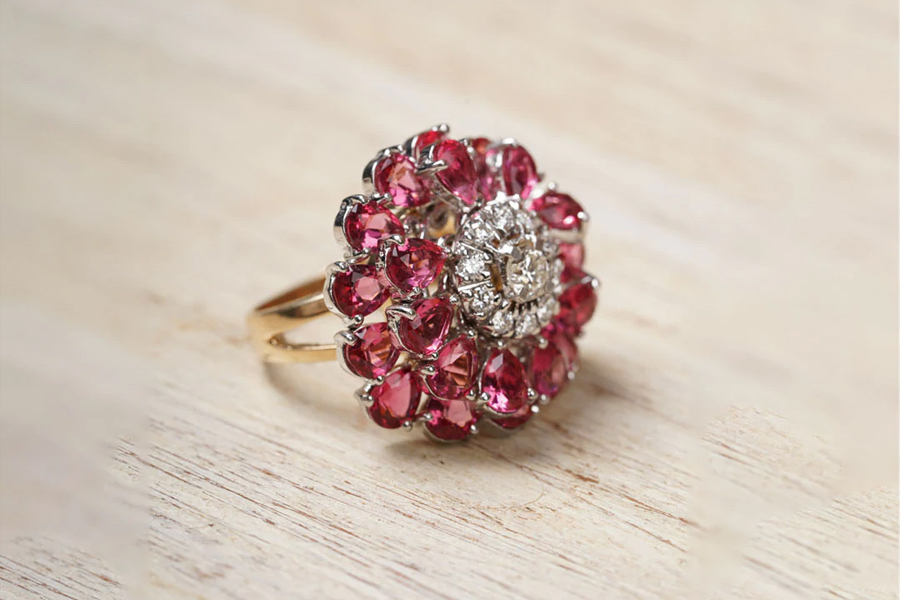
Aurus Jewels | Naaz Ring
Ring Settings
According to Diamond Nexus, "While the stone is arguably the show-stopping centerpiece of an engagement ring, the right setting can enhance everything from cut to color, make a small stone appear larger, and even safeguard stones against damage or loss."
Yes, the setting is kind of a big deal! And it can determine the entire style of your ring.
From channel set to the diamond-encrusted halo setting and the simple solitaire prong setting, there are several distinct styles of securing stones to the band. So how do you choose the right setting?
Besides personal style, lifestyle is really important to think about here. For instance, if you're a spin class junkie who also enjoys rock climbing and throwing pottery, it's best to not wear a tiny diamond-encrusted band every day. Choose something that makes sense and can stand up to your activity level. Here's a quick diagram to help you wrap your head around some of the most popular settings:
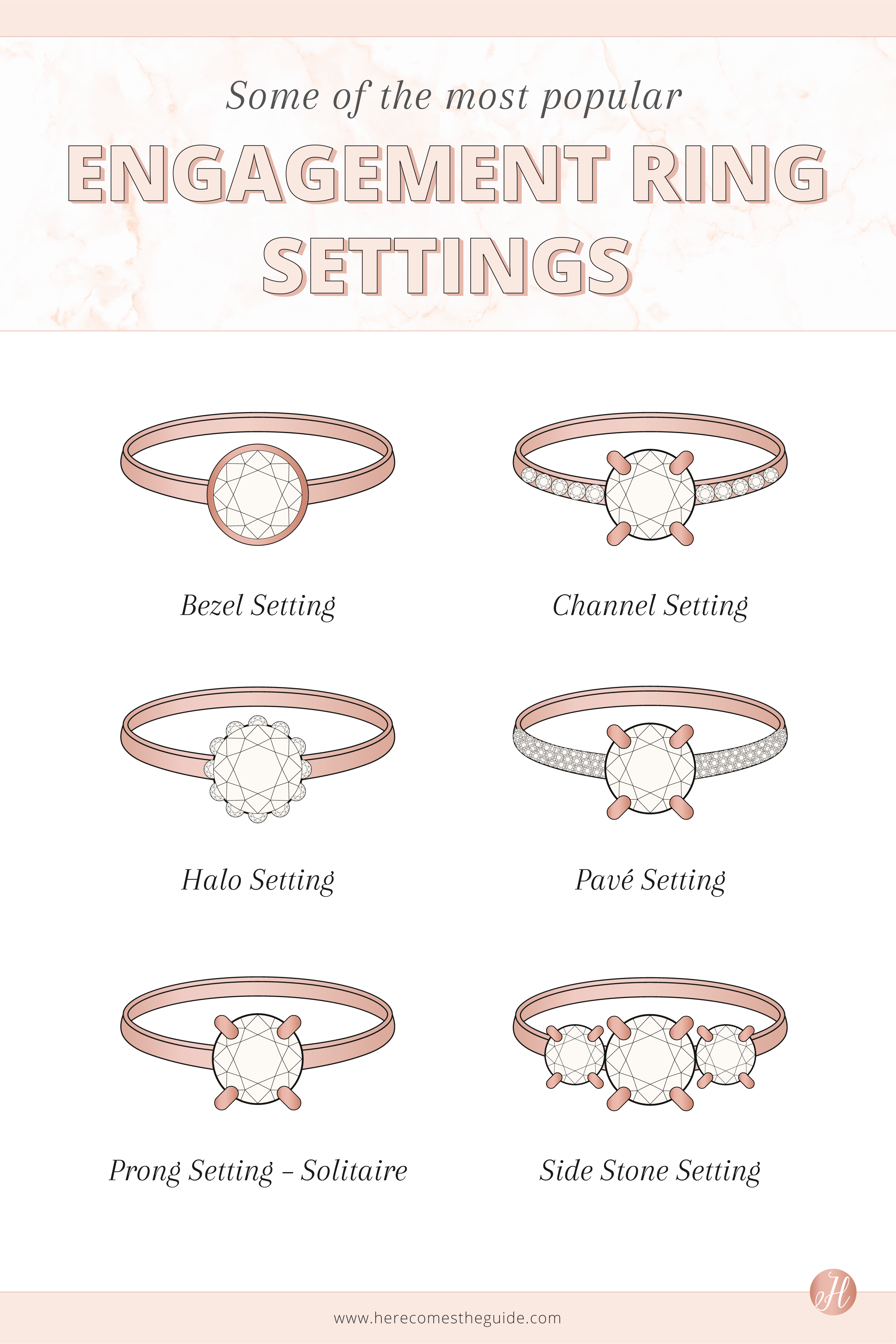
Ring Metals
Once you land on your stone and setting, you have one more style choice: Which precious metal should you pick? The most popular choices are yellow gold, white gold, rose gold, and platinum.
YELLOW GOLD
Yellow gold is a time-honored choice since it never changes color and is oh-so-classic. Opt for 14–18K gold for optimal strength and durability.
ROSE GOLD
Rose gold is also a great choice because it contains no nickel and doesn't tarnish. Plus, who can resist that shiny pink hue? (Have you seen our website?)
WHITE GOLD
Among the "gold" options, white gold currently reigns as the most popular choice. White gold is actually yellow gold with nickel and other metals added to make it whiter—then it's plated in rhodium for a bright white shine. Many clients are surprised that white gold is plated* and that it needs to be reapplied every few years; otherwise it slowly wears off and the metal has a yellowish hue. It's an easy process, though, and can be done at most local jewelers.
*This is super important to know because many people are allergic to nickel! As the plating wears off, the nickel becomes exposed and can cause an allergic reaction.
PLATINUM
Another white metal option is platinum—but what's the difference between platinum and white gold? Platinum is a denser metal, so it's heavier and rarer, making it more expensive. Platinum contains no nickel and doesn't need replating; however, since it's not plated, its surface scratches more easily than white gold and, over time, it takes on a duller silver finish, similar to that of sterling.
Pro Tip: Gold and platinum are used for jewelry because they are soft, malleable metals; that's something you always want to remember. It's understandable that you never want to take your ring off; however, there are a few instances where it's best to place it in a pretty ring box for safekeeping. Have one designated spot in your home where you put your ring when you are doing any activity that's hard on your hands. It's an expensive and heartfelt gift, and you want to remember to treat it that way.
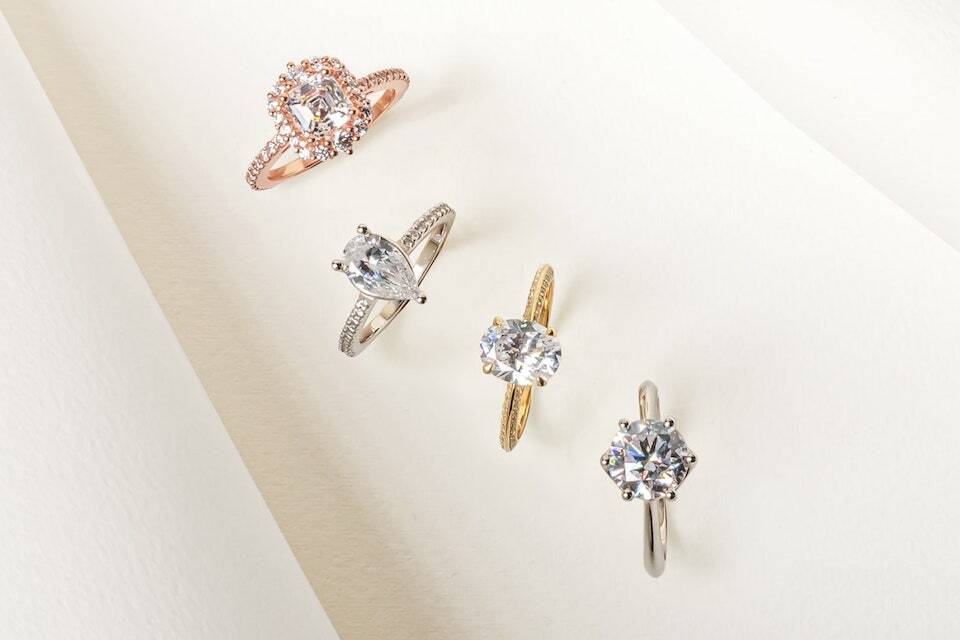
Diamond Nexus | The Nexus Diamond™ alternative
Frequently Asked Questions
How Do I Choose The Right Ring Style?
If your partner hasn't explicitly told you what ring they want, you can:
- raid their jewelry stash to see what their style is
- ask their closest friends or family members for advice
- ask your partner – if you don't mind ruining the element of surprise!
- keep your ears open to any hints your significant other may be dropping…
- consider their everyday style (simple, trendy, glam, boho, etc.)
- go ring shopping / browsing together
- simply trust your gut.
There are several ways to go about choosing the ring style your partner will love, so take your time, do your research, and trust those instincts!
How Do I Figure Out The Right Ring Size?
Before you actually buy a ring it's important to know your partner's ring size. Here are a few ways to do it:
- sneak one of their rings to a jeweler to check the size
- ask their closest friends or family members
- ask your partner – if you don't mind ruining the element of surprise!
Again, don't stress too much here. When in doubt, go a bit larger than the size you have in mind, since you can always get the ring sized down later. (It's easier to size a ring down than it is to size up.)
How Do I Afford An Engagement Ring???
I think we can all agree that the whole adage about spending 3 months' salary on an engagement ring is entirely outdated. There are no set rules here! It all depends on your current financial situation and your preferences.
Our resident jeweler Mary Claire Newcomb swears you can get an incredibly beautiful ring at an affordable price with the right jewelry professional: "I think the one thing I walked away from this industry surprised by is that if someone knows what they are doing, they can make an engagement ring that's 3k and looks identical to one that's 10k, so be firm about the budget and stick to it."
There are several options for affordable engagement rings, including:
- the diamond alternatives or gemstones listed above
- using a family heirloom or antique / vintage ring
- opting for just under full carat weight when purchasing a diamond
- scouring websites like Etsy for unique yet affordable rings
With so many beautiful and budget-friendly engagement ring options available, there's no reason to go into debt just to propose. (Let's not forget – a proposal means you've got a wedding to plan!) And just like some couples opt to have a small elopement now and a big party later, you can totally upgrade your ring in the future if you can't afford the "dream ring" right now.
Here's another idea: A placeholder or "loaner" engagement ring. Most jewelers will loan you a ring you can use to propose, with the intention of picking the real-deal dream ring with your partner later. OR, purchase an inexpensive (but still pretty or fun) cubic zirconia ring for your proposal; and later it can be worn in place of the real ring when it might get lost or damaged.
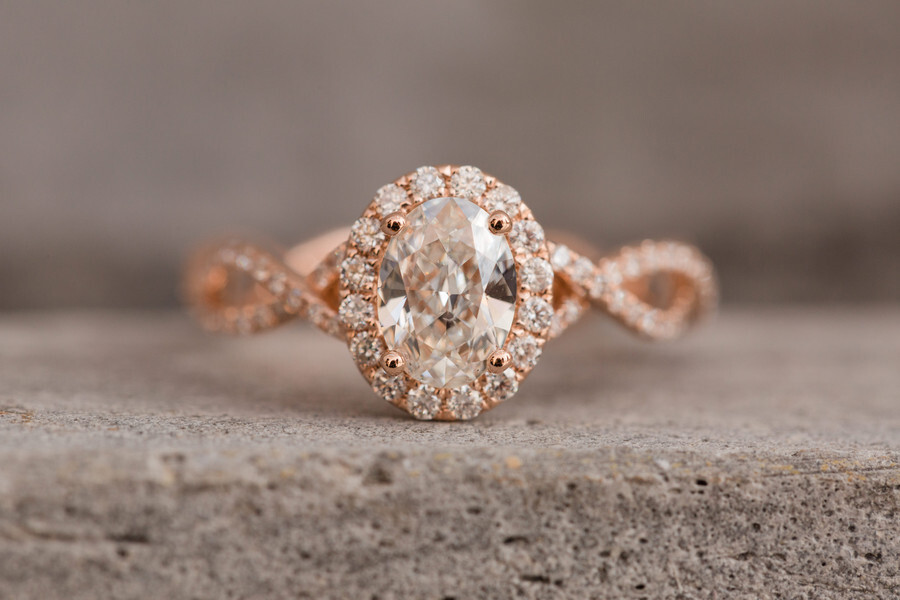
Frances J. Jewelers Custom Diamond Engagement Ring | Kate & Jill
Should I Buy The Ring Online or In-Store?
There are benefits to both, but whether you buy an engagement ring online or at a brick-and-mortar jewelry store will come down to personal preference.
Buying online may save you some money, since online retailers have almost zero overhead compared to traditional stores. You also get to shop an infinite selection of ring options and compare prices from the comfort of your couch!
Just make sure you purchase your ring from a reputable online retailer, that you review their shipping and return policies, and that you receive a GIA or AGS certificate with your diamond.
Buying in-person is great because you can not only see and compare the rings with your own two eyes, but you can talk to a jeweler directly to ask questions, get expert advice, and work with them to get the most bang for your buck.
Pro Tip: Ask friends and family members for recommendations on reputable local jewelers that they trust. If buying a diamond, finding a store that has GIA-certified gemologists on staff is ideal since they're highly trained in grading and pricing jewelry.
Should I Insure The Engagement Ring?
If you've made the investment in an engagement ring, you should absolutely insure it! Look into homeowners insurance, renters insurance, or straight-up jewelry insurance for that baby. It's super inexpensive (typically around 1–2% of the total value of your ring) and a lifesaver if it ever gets lost or stolen.
How Do I Pull Off An Epic Proposal?
Check out this article with 17 Ideas for Planning an Epic Proposal. You got this!
Are we friends yet? Join MyGuide for more goodness!
Some clients may have paid to be placed in our editorial and some of these links may be affiliate; however, we never include a venue, vendor, or product unless they have a proper place here. This is part of our Core Values. We create our website first and foremost to be good for the couples using it to plan their Big Day. We won't stray from that for a few advertising dollars. #scoutshonor


